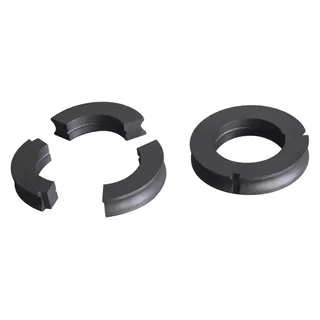Split seal rings are essential in rotating equipment, offering a cost-effective, easy-to-install solution that minimizes downtime. They boost operational efficiency, reduce maintenance challenges, and are ideal for large or hard-to-disassemble machinery. This article explores how split seal rings work, their key benefits, common materials, and the industries that rely on them.
What Are Split Seal Rings?
Split seal rings are components designed to prevent fluid or gas leakage in rotating or reciprocating machinery. Unlike traditional rings, their segmented design allows installation without dismantling surrounding equipment—ideal for large systems like turbines, compressors, and pumps. This reduces labor and minimizes downtime.
How Split Seal Rings Work
Split seal rings are designed to maintain a tight seal while accommodating thermal expansion, shaft misalignment, and vibration. The segments align tightly when assembled around a shaft to form a continuous seal. A clamping mechanism or retainer ring often secures the seal in place.
These rings function similarly to solid seal rings by providing a barrier against fluid leaks, maintaining system pressure, and protecting internal components from external contaminants. However, their segmented construction allows them to handle mechanical flexing and wear more efficiently over time.
Key Benefits of Using Split Seal Rings
- Ease of Installation
Split seal rings are significantly easier to install than their solid counterparts. They can be fitted around the shaft without dismantling the equipment, making them ideal for maintenance in tight or high-risk environments.
- Reduced Downtime
One of the most important advantages is the reduction in machine downtime. Traditional seals may require complete disassembly, leading to hours or even days of halted production. With split seals, repairs or replacements can often be completed in a fraction of the time.
- Lower Maintenance Costs
Because split seal rings are easier and faster to replace, labor costs are significantly reduced. Additionally, avoiding disassembly minimizes the risk of damaging other equipment parts during maintenance.
- Reliable Performance
High-quality split seal rings offer performance on par with solid seals. They provide reliable sealing capabilities while accommodating shaft misalignments and environmental challenges like vibration or thermal cycling.
- Versatility
Split seals are available in various sizes and materials, making them suitable for diverse industrial applications. They can be customized for high-temperature, high-pressure, or chemically aggressive environments.
Common Materials Used
The effectiveness of a split seal ring largely depends on the material from which it is made. Common materials include:
- Carbon Graphite – Ideal for high-temperature applications with excellent self-lubrication and wear resistance.
- PTFE (Polytetrafluoroethylene) – Chemically inert and suited for food, pharmaceutical, and chemical industries.
- Metal-Backed Composites – Offer added structural strength and heat dissipation.
- Ceramic-Filled Polymers – Enhance thermal resistance and wear properties for aggressive conditions.
Material selection depends on application-specific factors like fluid compatibility, temperature range, rotational speed, and pressure.
Applications of Split Seal Rings
Split seal rings are used in a variety of industries and applications, including:
- Power Generation – Steam and gas turbines rely on them for fast seal replacement without costly shutdowns.
- Oil & Gas – Compressors and pumps in refineries benefit from their quick maintenance capability.
- Pulp & Paper – Process equipment like agitators and vacuum pumps uses split seals to keep production lines moving.
- Chemical Processing – Reactors and mixers utilize chemically resistant split rings to maintain safety and integrity.
- Marine & Shipping – Engines and pumps in confined spaces can be serviced easily with split seals.
Keep Your Operations Running Smoothly
While split seal rings deliver easy installation, reduced downtime, and reliable performance, they carry a few caveats: higher upfront cost (often offset by lower maintenance expenses), precise alignment during installation, and the importance of choosing the correct material to prevent premature wear.
Partnering with an experienced supplier ensures you select the right design and installation procedure for your application. Overall, split seal rings offer a high‑performance, cost‑effective sealing solution for turbines, compressors, pumps, and mixers—streamlining maintenance, boosting efficiency, and cutting long‑term operational costs.
